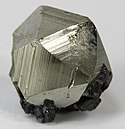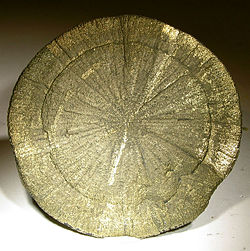Pyrite concretion (tributary of Waugh Run, Ross County, Ohio, USA) 1 (18994590058)
Pyrite concretion ("sea serpent") from the Devonian of Ohio, USA. (CMC RM1250, rocks and minerals collection, Cincinnati Museum of Natural History & Science, Cincinnati Museum Center, Cincinnati, Ohio, USA)
A mineral is a naturally-occurring, solid, inorganic, crystalline substance having a fairly definite chemical composition and having fairly definite physical properties. At its simplest, a mineral is a naturally-occurring solid chemical. Currently, there are over 4900 named and described minerals - about 200 of them are common and about 20 of them are very common. Mineral classification is based on anion chemistry. Major categories of minerals are: elements, sulfides, oxides, halides, carbonates, sulfates, phosphates, and silicates.
The sulfide minerals contain one or more sulfide anions (S-2). The sulfides are usually considered together with the arsenide minerals, the sulfarsenide minerals, and the telluride minerals. Many sulfides are economically significant, as they occur commonly in ores. The metals that combine with S-2 are mainly Fe, Cu, Ni, Ag, etc. Most sulfides have a metallic luster, are moderately soft, and are noticeably heavy for their size. These minerals will not form in the presence of free oxygen. Under an oxygen-rich atmosphere, sulfide minerals tend to chemically weather to various oxide and hydroxide minerals.
Pyrite is a common iron sulfide mineral (FeS2). It’s nickname is “fool's gold”. Pyrite has a metallic luster, brassy gold color (in contrast to the deep rich yellow gold color of true gold - www.flickr.com/photos/jsjgeology/sets/72157651325153769/), dark gray to black streak, is hard (H=6 to 6.5), has no cleavage, and is moderately heavy for its size. It often forms cubic crystals or pyritohedrons (crystals having pentagonal faces).
Pyrite is common in many hydrothermal veins, shales, coals, various metamorphic rocks, and massive sulfide deposits.
Stratigraphy: probably from the Ohio Shale, Upper Devonian
Locality: creek exposure along a tributary of Waugh Run, Ross County, south-central Ohio, USA
Photo gallery of pyrite:
www.mindat.org/gallery.php?min=3314Relevante Bilder
































Relevante Artikel
PyritPyrit, auch als Schwefelkies oder Eisenkies sowie Katzen- oder Narrengold bekannt, ist ein sehr häufig vorkommendes Mineral aus der Klasse der „Sulfide und Sulfosalze“. Chemisch gesehen ist es die kubische Modifikation des Eisen(II)-disulfids mit der chemischen Zusammensetzung FeS2, besteht also aus Eisen und Schwefel im Stoffmengenverhältnis von 1 : 2. .. weiterlesen
